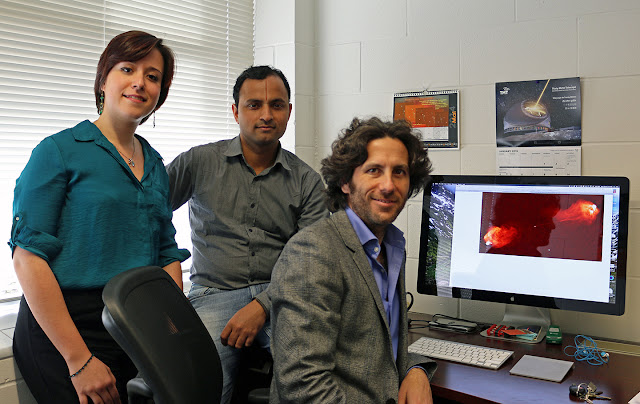Clemson scientists find out five new galaxies powered through black holes
Scientists at Clemson university have recognized five of the oldest and largest gamma-ray blazars yet recognized, a discovery that could liberate the mysteries of deep space.
in keeping with Clemson university astrophysicist Marco Ajello, a blazar is a sort of active galactic nuclei – a supermassive black hole in the middle of a galaxy with a huge disk of being counted whirling round it. As rely falls into the supermassive black hole, it emits powerful jets of gamma radiation that circulate close to the velocity of light.
when the jets are aimed towards Earth, it seems in particular bright to telescopes and other instruments. That permits researchers like Ajello to take a look at a number of the oldest black holes within the universe.
The gamma rays from the newly located blazars traveled at the speed of light for as a minimum 1.2 billion years earlier than reaching Earth. previously, the maximum remote blazar galaxy emitted its light when the universe was 2.1 billion years old. meaning the brand new blazars are a number of the oldest ever discovered, Ajello said.
Watch below to study greater about the discovery:
additionally, the supermassive black holes in the blazars are a whole lot larger than Earth's sun.
Scientists measure the size of celestial bodies in solar loads, with a single solar mass equivalent to the dimensions of the sun. of the black holes weigh at the least 1 billion sun masses, that means the matter is continuously falling inward, corralled right into a disk and heated before making the final plunge to the black hole. The supermassive black hole at the middle of our galaxy, in assessment, has a mass of 4 to five million times the sun.
"The discovery of these supermassive black holes, which launch jets that emit more energy in one second than our sun will produce in its entire lifetime, was the culmination of a yearlong research project," Ajello stated.
Ajello carried out his research with graduate college students Vaidehi Paliya and Lea Marcotulli, and an international group of scientists from the Fermi large array Telescope collaboration. That includes Roopesh Ojha, an astronomer at NASA's Goddard area Flight middle in Maryland, and Dario Gsparrini of the Italian space agency.
The crew of scientists used NASA's Fermi Gamma-Ray area Telescope to locate the five previously undiscovered gamma-ray blazars. In truth, current accuracy upgrades considerably boosted the telescope's sensitivity, allowing it to process snapshots from deep space.
"People are calling it the cheapest refurbishment in history," Ajello stated. "Normally, for the Hubble Space Telescope, NASA had to send someone up to space to physically make these kinds of improvements. But in this case, they were able to do it remotely from an Earth-bound location. And of equal importance, the improvements were retroactive, which meant that the previous six years of data were also entirely reprocessed."
at the same time as gamma-ray emissions can't be visible with the aid of the naked eye, the Fermi telescope can spot them and translate them into facts. Over the route of 12 months, Ajello and his team sifted through a catalog of approximately 1.4 million quasars, that are galaxies with energetic supermassive black holes at their center, and identified the 5 undiscovered blazars.
however, as with many discoveries, the findings gift extra questions. That consists of the thriller of how the newly discovered black holes grew to become as a minimum 1 billion sun masses in just 1.4 billion years. In terms of cosmic measures, that's barely enough time for a black hole to attain such monstrous proportions.
"Is it because one black hole ate a lot all the time for a very long time? Or maybe because it bumped into other black holes and merged into one? To be honest, we have no observations supporting either argument," Ajello stated.
"There are mechanisms at work that we have yet to unravel. Puzzles that we have yet to solve," he endured. "When we do eventually solve them, we will learn amazing things about how the universe was born, how it grew into what it has become, and what the distant future might hold as the universe continues to progress toward old age."
Ajello and the other scientists plan to look for more remote blazar galaxies to understand the emission mechanisms that makes them so powerful. The newly located galaxies' accompanying accretion disks – rotating swirls of being counted that orbit the black holes – emit greater than 2 trillion times the energy output of Earth's sun.



Comments
Post a Comment